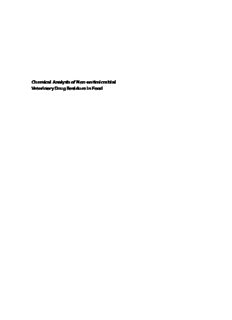
Chemical analysis of non-antimicrobial veterinary drug residues in food PDF
Preview Chemical analysis of non-antimicrobial veterinary drug residues in food
(cid:2) ChemicalAnalysisofNon-antimicrobial VeterinaryDrugResiduesinFood (cid:2) (cid:2) (cid:2) (cid:2) WILEYSERIESONMASSSPECTROMETRY SeriesEditors DominicM.Desiderio DepartmentsofNeurologyandBiochemistry UniversityofTennesseeHealthScienceCenter JosephA.Loo DepartmentofChemistryandBiochemistryUCLA FoundingEditors NicoM.M.Nibbering(1938–2014) DominicM.Desiderio Acompletelistofthetitlesinthisseriesappearsattheendofthisvolume. (cid:2) (cid:2) (cid:2) (cid:2) Chemical Analysis of Non-antimicrobial Veterinary Drug Residues in Food EditedbyJackF.Kay,JamesD.MacNeil,andJianWang (cid:2) (cid:2) (cid:2) (cid:2) Copyright©2017byJohnWiley&Sons,Inc.Allrightsreserved PublishedbyJohnWiley&Sons,Inc.,Hoboken,NewJersey PublishedsimultaneouslyinCanada Nopartofthispublicationmaybereproduced,storedinaretrievalsystem,ortransmittedinany formorbyanymeans,electronic,mechanical,photocopying,recording,scanning,orotherwise, exceptaspermittedunderSection107or108ofthe1976UnitedStatesCopyrightAct,without eitherthepriorwrittenpermissionofthePublisher,orauthorizationthroughpaymentofthe appropriateper-copyfeetotheCopyrightClearanceCenter,Inc.,222RosewoodDrive,Danvers, MA01923,(978)750-8400,fax(978)750-4470,oronthewebatwww.copyright.com.Requeststo thePublisherforpermissionshouldbeaddressedtothePermissionsDepartment,JohnWiley& Sons,Inc.,111RiverStreet,Hoboken,NJ07030,(201)748-6011,fax(201)748-6008,oronlineat http://www.wiley.com/go/permissions. LimitofLiability/DisclaimerofWarranty:Whilethepublisherandauthorhaveusedtheirbestefforts inpreparingthisbook,theymakenorepresentationsorwarrantieswithrespecttotheaccuracyor completenessofthecontentsofthisbookandspecificallydisclaimanyimpliedwarrantiesof merchantabilityorfitnessforaparticularpurpose.Nowarrantymaybecreatedorextendedbysales representativesorwrittensalesmaterials.Theadviceandstrategiescontainedhereinmaynotbe suitableforyoursituation.Youshouldconsultwithaprofessionalwhereappropriate.Neitherthe publishernorauthorshallbeliableforanylossofprofitoranyothercommercialdamages,including butnotlimitedtospecial,incidental,consequential,orotherdamages. Forgeneralinformationonourotherproductsandservicesorfortechnicalsupport,pleasecontact ourCustomerCareDepartmentwithintheUnitedStatesat(800)762-2974,outsidetheUnited Statesat(317)572-3993orfax(317)572-4002. (cid:2) (cid:2) Wileyalsopublishesitsbooksinavarietyofelectronicformats.Somecontentthatappearsinprint maynotbeavailableinelectronicformats.FormoreinformationaboutWileyproducts,visitour websiteatwww.wiley.com. LibraryofCongressCataloging-in-PublicationData Names:Kay,JackF.,editor.|MacNeil,JamesD.,editor.|Wang,Jian,1964- editor. Title:Chemicalanalysisofnon-antimicrobialveterinarydrugresiduesin food/editedbyJackF.Kay,JamesD.MacNeil,JianWang. Description:Hoboken,NewJersey:JohnWiley&Sons,Inc.,[2017]|Includes bibliographicalreferencesandindex. Identifiers:LCCN2016033527|ISBN9781118695074(cloth)|ISBN9781119325901 (epub) Subjects:LCSH:Veterinarydrugresidues.|Foodcontamination. Classification:LCCRA1270.V47C44252017|DDC664/.07–dc23LCrecordavailableat https://lccn.loc.gov/2016033527 Setin10/12pt,WarnockProbySPiGlobal,Chennai,India PrintedintheUnitedStatesofAmerica 10 9 8 7 6 5 4 3 2 1 (cid:2) (cid:2) ThisbookisdedicatedtothememoryofDr.JohnJ.O’RangersJr.,11June1936–20 January2013. Johnwasinternationallywellknownandrespectedinthefieldofveterinarydrug residuechemistryandinternationalregulations.BothDr.JamesMacNeilandDr. JackKaywerehonoredtohaveknownandworkedwithhimovermanyyearsand alsotocallhimafriend.Developinginternationalcooperationand understandingwasacornerstoneofJohn’sviewoflifeandworkethic,regardless ofthemorepoliticallyopinionatedviewsheldbysome.Manyinternational developmentsinthisfieldandfriendshipsaretheresultoftheworkJohn conductedbehindthescenestobreakdownbarriers.Hetrulywasoneofakind andhispassingleavesusallimpoverished. (cid:2) (cid:2) (cid:2) (cid:2) vii Contents Preface xix ListofContributors xxi AbouttheEditors xxv 1 BasicConsiderationsfortheAnalystforVeterinaryDrug ResidueAnalysisinAnimalTissues 1 JamesD.MacNeilandJackF.Kay 1.1 Introduction 1 1.2 Pharmacokinetics 1 (cid:2) (cid:2) 1.3 MetabolismandDistribution 3 1.4 ChoiceofAnalyticalMethod 5 1.5 ImportanceofRegulatoryLimits 7 1.5.1 DerivationoftheAcceptableDailyIntake 7 1.5.2 DerivationoftheAcuteReferenceDose 9 1.5.3 DerivationofMaximumResidueLimits 10 1.5.4 DerivationofTolerances 12 1.6 InternationalObligationsforRegulatoryAnalyticalLaboratories 13 1.6.1 LaboratoryAccreditation 13 1.6.2 ValidationofAnalyticalMethods 14 1.6.3 ConsistentUseofTerminology 15 1.6.4 SampleHandlingandRetention 16 1.6.5 ConfirmatoryAnalysis 17 1.6.6 QualityAssuranceMeasures 19 1.6.7 ProficiencyTesting 19 1.6.8 ReportingofResults 19 1.7 Conclusions 21 References 21 (cid:2) (cid:2) viii Contents 2 EmergingTechniquesinSampleExtractionandRapid Analysis 27 WendyC.Andersen,SherriB.Turnipseed,andJackJ.Lohne 2.1 Introduction 27 2.2 SampleExtraction 28 2.2.1 SolventExtractionandProteinPrecipitation 29 2.2.2 PhaseSeparationbySalt-InducedPartitioning 30 2.2.3 PhaseSeparationbyLow-TemperaturePartitioning 30 2.2.4 PhysicalSeparationbyultra-filtration 31 2.2.5 SampleExtractionwithGreenChemistryTechniques 32 2.2.5.1 PressurizedLiquidExtraction 32 2.2.5.2 RoomTemperatureIonicLiquids 32 2.2.5.3 Ultrasound-AssistedExtraction 33 2.2.5.4 Microwave-AssistedExtraction 34 2.3 ExtractClean-upwithSolid-PhaseSorbents 34 2.3.1 Solid-PhaseExtractionFormats 35 2.3.1.1 CartridgeSPE 35 2.3.1.2 OnlineCartridgeSPE 35 2.3.1.3 TurbulentFlowClean-up 35 2.3.1.4 DispersiveSPE 36 2.3.1.5 MatrixSolid-PhaseDispersion 37 (cid:2) 2.3.1.6 SupportedLiquidExtraction 38 (cid:2) 2.3.2 Solid-PhaseSorbentChemistry 38 2.3.2.1 SorbentsforSPEanddSPE 38 2.3.2.2 MolecularRecognitionBasedonMolecularlyImprinted Polymers 39 2.3.2.3 MolecularRecognitionBasedonAptamers 40 2.3.2.4 RestrictedAccessMaterials 41 2.3.2.5 Nanomaterials 43 2.4 Micro-extractionTechniquesforSolventandSorbentExtraction 47 2.4.1 SolventMicro-extraction 47 2.4.1.1 SingleDropMicro-extraction 47 2.4.1.2 DispersiveLiquid–LiquidMicro-extraction 48 2.4.1.3 HollowFiberMicro-extraction 50 2.4.2 SorbentMicro-extraction 51 2.4.2.1 Solid-PhaseMicro-extraction 52 2.4.2.2 StirBarSorptiveExtraction 52 2.4.2.3 FabricPhaseSorptiveExtraction 53 2.5 EmergingTechniquesinLiquidChromatography 54 2.5.1 UltrahighPerformanceLiquidChromatography 54 2.5.2 Core–ShellColumns 54 2.5.3 HydrophilicInteractionLiquidChromatography 55 2.5.4 OtherEmergingLCTechniques 56 2.6 DirectMassSpectrometryAnalysisofSampleExtracts 57 (cid:2) (cid:2) Contents ix 2.6.1 FlowInjectionMassSpectrometry 57 2.6.2 DirectDesorption/IonizationMassSpectrometry 58 2.6.2.1 APCI-BasedTechniques 59 2.6.2.2 ESI-BasedTechniques 63 2.6.3 DirectMSConsiderationsforRegulatoryAnalysis 65 2.7 IonMobilitySpectrometry 66 2.8 Conclusions 67 References 68 3 CapabilitiesandLimitationsofHigh-ResolutionMass Spectrometry(HRMS):time-of-flightandOrbitrapTM 93 AntonKaufmannandPhilTeale 3.1 AvailableTechnology 93 3.1.1 TOF 94 3.1.2 OrbitrapTM 99 3.2 CapabilitiesandLimitationsoftheTechnologyasComparedto LC-MS/MS(TandemQuadrupoleMassSpectrometer) 104 3.2.1 Selectivity 105 3.2.2 Quantification 108 3.2.3 Sensitivity 108 3.2.4 ValidationofHRMS-BasedMethods 110 (cid:2) 3.2.5 MethodDiagnosisTools 112 (cid:2) 3.3 AnalyticalMethodsforVeterinaryDrugResidues 112 3.3.1 InitialApplications(Non-antimicrobialVeterinaryDrugs) 112 3.3.2 MethodsLimitedtoaSingle-DrugGroup 113 3.3.3 MethodsCoveringMultiple-DrugGroups 114 3.3.4 MethodComponents 115 3.3.4.1 ExtractionandClean-up 115 3.3.4.2 Separation 117 3.3.5 ResidueTestingofAnabolicSteroidsandGrowthPromoters 119 3.4 DopingControl 121 3.4.1 GC-HRMS 121 3.4.2 AccurateMassLC-MSandLC-MS/MSinDopingControl 122 3.4.3 “DiluteandShoot”withAccurateMassLC-MS 123 3.5 AccurateMassMSinResearchandMetabolismStudies 124 3.6 DesignerDrugsandGenericDetectionStrategies 125 3.6.1 MetabolomicsinFood/ResidueAnalysis 127 3.7 TheFutureofAccurateMassSpectrometryinResidueAnalysis 129 References 131 4 Hormonesand𝛃-Agonists 141 LeendertA.vanGinkel,ToineBovee,MarcoH.Blokland,SaskiaS.Sterk, NathalieG.E.Smits,JelkaPleadinandAnaVulic´ 4.1 Introduction 141 (cid:2) (cid:2) x Contents 4.2 AdvancesinClassicalAnalysisofExogenousSynthetic Hormones 143 4.2.1 Multi-methods:Multi-residueMethods(MRMs)andMulti-class, Multi-residueMethods(MCMRs) 143 4.2.2 AlternativesinSamplePreparationandClean-up 144 4.2.2.1 Generic 144 4.2.2.2 QuEChERS 144 4.2.2.3 MolecularlyImprintedPolymers(MIPs) 154 4.2.2.4 Hollow-FiberMicro-extractionsandSimilarTechniques 154 4.2.2.5 DiluteandShoot 155 4.2.3 AdvancesinSeparation 155 4.2.3.1 MiniaturizedSeparationTechniques 155 4.2.3.2 TurbulentFlowLC 156 4.2.3.3 IonMobilitySpectrometry 156 4.2.3.4 TechniquestoFacilitateIRMS:High-TemperatureLC, Two-DimensionalChromatography,andOthers 156 4.2.4 AdvancesinDetection 157 4.2.4.1 Isotope-RatioMassSpectrometry(IRMS) 158 4.2.4.2 AmbientIonizationMassSpectrometry(AMS) 158 4.2.4.3 OtherTechniques 159 4.2.5 ClassicandNewAnalyticalMatrices 160 (cid:2) (cid:2) 4.2.6 ConclusionsonAnalysisofExogenousSyntheticHormones 161 4.3 Bio-BasedScreeningMethodsforSteroidHormones,β-Agonists,and GrowthHormones 161 4.3.1 Estrogens 162 4.3.1.1 BindingAssaysforEstrogens 162 4.3.1.2 BioassaysforEstrogens 164 4.3.2 Androgens 166 4.3.2.1 BindingAssaysforAndrogens 166 4.3.2.2 BioassaysforAndrogens 168 4.3.3 MetabolicProfilingAssaytoDetectAbuseofEstrogensand Androgens 171 4.3.4 ProgestagensandGlucocorticoids 171 4.3.4.1 BindingAssaysforProgestagensandGlucocorticoids 171 4.3.4.2 BioassaysforProgestagensandGlucocorticoids 172 4.3.5 Thyreostatics 173 4.3.6 β-Agonists 175 4.3.6.1 BindingAssaysforβ-Agonists 175 4.3.6.2 Bioassaysforβ-Agonists 176 4.3.7 GrowthHormones 177 4.3.7.1 RecombinantGrowthHormoneinCattle 177 4.3.7.2 GrowthHormoneinFish 178 4.3.7.3 GrowthHormoneinHorse 179 (cid:2) (cid:2) Contents xi 4.3.8 ConclusionsandFutureDevelopmentsinBio-BasedScreening Methods 179 4.4 NaturalHormones 180 4.4.1 NaturalCompoundsFormedDuringtheDigestionProcess 182 4.4.1.1 Prednisolone 182 4.4.2 Feed-RelatedCompounds 183 4.4.2.1 Thiouracil 183 4.4.2.2 Zeranol 184 4.4.3 TheNaturalHormones17β-Estradiol,17β-Testosterone,and Progesterone 186 4.4.4 Nortestosterone 189 4.4.5 Boldenone 192 4.4.6 ProteinHormones 195 4.4.6.1 Insulin 195 4.4.6.2 Insulin-LikeGrowthFactor-1(IGF-1) 196 4.4.6.3 GrowthHormone 196 4.4.6.4 GrowthHormoneSecretagogues 197 4.4.7 FuturePerspectives(NaturalHormones) 199 4.5 ControlforSyntheticβ-Agonists:ScreeningandConfirmatory Methods 199 4.5.1 BasicInformationonNatureandRegulatoryControls 199 (cid:2) 4.5.2 MechanismofAction 201 (cid:2) 4.5.3 TherapeuticUseandAbuse 202 4.5.4 AbsorptionandElimination 203 4.5.5 BioavailabilityandResidues 203 4.5.6 DeterminationinBiologicalMaterials 204 4.5.6.1 SamplePreparationTechniques 204 4.5.6.2 ScreeningMethods 206 4.5.6.3 CurrentApproachesinAnalysisofβ-Agonists 206 4.5.7 FuturePerspective(β-Agonists) 208 References 210 5 AnalysisofAnthelminticandAnticoccidialDrugResiduesin Animal-DerivedFoods 245 SarahTuck,AmbroseFureyandMartinDanaher 5.1 Introduction 245 5.2 ChemistryandModeofAction 246 5.2.1 Benzimidazoles 246 5.2.2 Imidazothiazoles 249 5.2.3 Tetrahydropyrimidines 249 5.2.4 Organophosphates 250 5.2.5 Flukicides 251 5.2.6 MacrocyclicLactones 251 5.2.7 OtherAnthelminticDrugs 252 (cid:2)
